“Glory is fleeting, but obscurity is forever”, Napoleon once said.
No one can accuse Napoleon of obscurity. Whether you think him a military genius or ruthless dictator – or both – he is certainly one of the most famous figures in French history. For anyone fascinated by Napoleon there is much to be seen in France and further afield that has associations with his extraordinary life – from battlefields to palaces to grand monuments.
Explore them all with LeShuttle.
Who was Napoleon?
Napoleon rose from rather obscure (though not humble) beginnings in Corsica to become the first Emperor of the French. He built an empire that dominated Europe in the early 19th century. He was a brilliant military commander and astute political leader, who took his armies beyond Europe on a scale not seen since the Roman Empire. He fought battles that echo down the ages – Austerlitz, Ulm, Leipzig, Waterloo. Many of his political and economic ideas were ahead of their time.
But his legacy is tainted. The Napoleonic Wars cost millions of lives. He tolerated slavery, plundered treasures from other nations and ultimately left France much weaker than it had been before.
From birth in Corsica to exile on Saint Helena
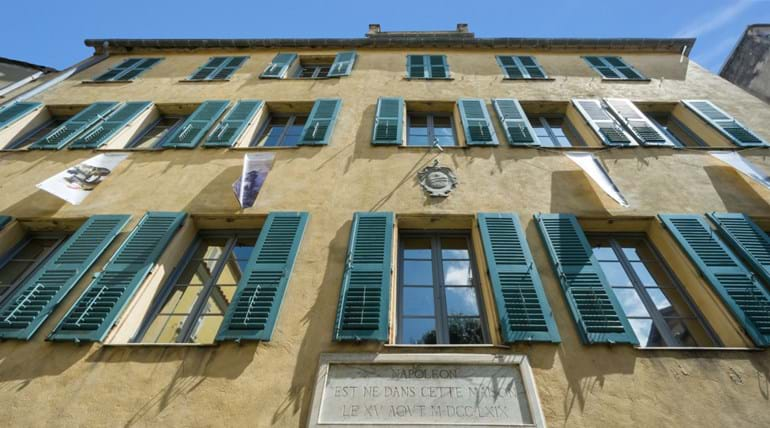 Napoleon’s birthplace in Ajaccio, Corsica
Napoleon’s birthplace in Ajaccio, Corsica
Napoleon Bonaparte was born in Ajaccio, Corsica in 1769. His family home on the island is now a national museum, Maison Bonaparte. Intrepid Napoleon travellers can visit by taking the ferry from Toulon – it’s an 11-hour drive to Toulon from our Calais terminal (with tolls) but if you’re on a France road trip it could be a nice day’s excursion off the mainland. The museum is fascinating – Napoleon returned to the house several times during his life, most notably in 1799 after his Egyptian campaign. In one of the rooms is a trap door that Napoleon is said to have used to secretly enter the port of Ajaccio.
Islands play a major role in the Napoleon story. His first exile was on the island of Elba. Then after the battle of Waterloo in 1815, he surrendered to the British and was exiled to the remote island of Saint Helena in the south Atlantic, where he died in 1821.
Napoleon’s France
After coming to power in 1799, Napoleon spent much of his time on military campaigns abroad. But wherever he went in France he left a mark.
Tuileries Palace and the Louvre
The Tuileries Palace in Paris is no more, but it is easy to see where it once stood, opposite the Jardin de Tuileries on the Right Bank of the Seine. The Pavillon de Marsan and Pavillion de Flore, at either end, are the only remnants, although both have been significantly rebuilt. Napoleon spent more time living at the Tuileries Palace in the early years of his reign than any other of his residences.
The Tuileries was connected to the Louvre Palace, and it was Napoleon who made the Louvre into the prestigious museum we know today. Never one for humility, he renamed it the Napoleon Museum! It housed many of the artworks he brought back as spoils of war.
Arc de Triomphe
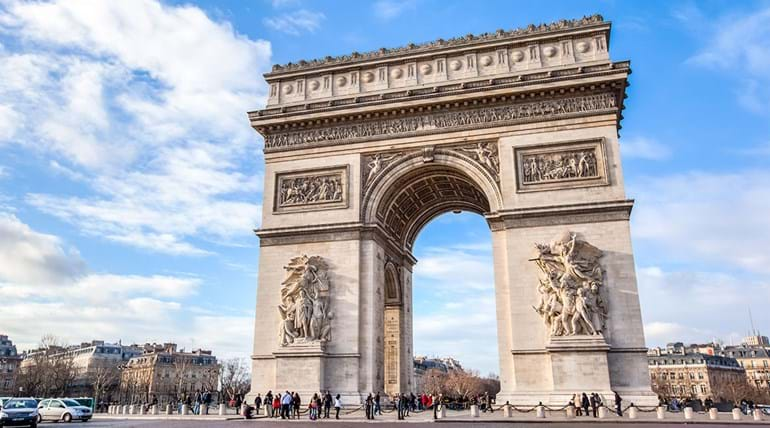 The Arc de Triomphe was commissioned by Napoleon in 1806
The Arc de Triomphe was commissioned by Napoleon in 1806
Napoleon commissioned the Arc de Triomphe after his victory at the Battle of Austerlitz in 1806, at the height of his power. It was not to be completed until 1836, but when Napoleon returned to Paris in 1810 he had a wooden replica built that he could pass under. At 50m high, it was the tallest triumphal arch in the world for over 100 years, and is with the Eiffel Tower the most recognisable landmark in Paris. The Arc de Triomphe honours those who died in the French Revolutionary Wars and Napoleonic Wars, and plays a key role in French national life.
No trip to Paris is complete without a stroll down the Champs-Élysées towards Napoleon’s great arch. Look out for the underground entrance – it’s the only safe way to get across the chaotic lanes of traffic at the Place Charles de Gaulle.
Notre-Dame
The gothic glory of the Cathedral of Notre-Dame has seen many spectacles in its time, but surely none greater than Napoleon’s coronation as ‘Emperor of the French’ in 1804. Overseen by the Pope, the ceremony saw Napoleon characteristically crown himself, watched by 20,000 invited guests inside the cathedral. The ceremony reportedly lasted six hours, amid much pomp, pageantry and ritual.
Restoration work is still taking place at Notre-Dame after the fire of 2019, but the cathedral is expected to reopen to the public in 2024.
Les Invalides
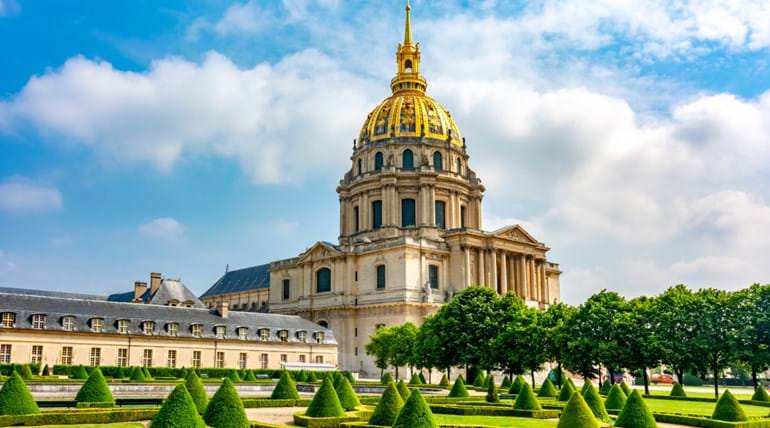 Cathédrale Saint-Louis, Les Invalides, Paris
Cathédrale Saint-Louis, Les Invalides, Paris
Napoleon’s final resting place was not to be Saint Helena, but under the great golden dome of Les Invalides, the estate of military hospitals, museums and monuments in the 7th arrondissement. Napoleon’s body was repatriated and returned for a state funeral in Paris in 1840 and his tomb now resides in the open crypt of Saint-Louis Cathedral at Les Invalides. The red sarcophagus is quite an astonishing sight. Visiting the tomb of Napoleon is included in the admission ticket to the Musée de l’Armée, which also houses an extensive Napoleon collection.
La Colonne de la Grande Armée
It was a long held ambition of Napoleon to invade England. In 1804 he had amassed a huge invasion force at Boulogne and was just waiting for the right moment. He was foiled by the weather, amongst other things, and the flotilla never launched. But while his soldiers waited for their orders they agreed to pay for a monument to their commander out of their own wages, and this is ‘La Colonne de la Grande Armée’ that stands just outside Boulogne-sur-Mer today. The 54 metre high column has a statue of Napoleon at the top, facing inland – a reference, some think, to him turning his back on his enemy across the Channel.
Château de Malmaison
The house that Napoleon’s first wife Josephine bought in 1799 to the west of Paris was the Imperial couple’s refuge in the country. Josephine made it her own, planting the rose garden and filling it with works of art and luxurious furnishings. Château de Malmaison was used by Napoleon as a seat of government, and after their divorce Josephine continued to live there. Today it is a museum with many marvellous rooms and original features from the time, including a harp in the music room that the Empress once played.
Driving to Château de Malmaison from our Calais terminal takes around 3 hours (with tolls).
Château de Fontainebleau
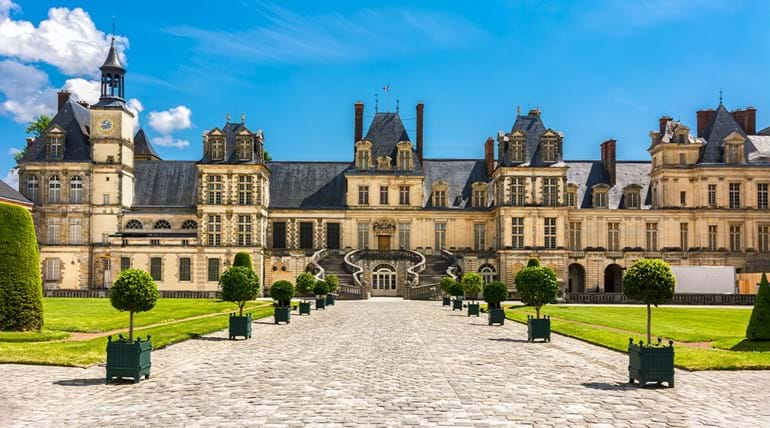 Château de Fontainebleau, ‘the true home of Kings’
Château de Fontainebleau, ‘the true home of Kings’
Called the ‘true residence of Kings’ by Napoleon, there was little doubt that once he made himself Emperor, Château de Fontainebleau would become one of his favourite residences. It had been the home of French royalty for hundreds of years, and Napoleon breathed new life into it, restoring and refurbishing it through the rest of his reign. The Throne Room and the Horseshoe Staircase are perhaps the highlights of any visit to Fontainebleau. The staircase was the scene of Napoleon’s emotional farewell to the Imperial Guard after abdicating in 1814.
The château lies to the south of Paris and is just over a 4 hour drive (with tolls) from LeShuttle’s Calais terminal.
Further afield in Europe
Just as Napoleon took his armies to distant dominions, so perhaps you may be tempted to follow his trail beyond the boundaries of France – though perhaps not as far as Russia or Egypt!
Leipzig
The Battle of Leipzig or the ‘Battle of the Nations’ signified the beginning of the end for Napoleon’s Empire. In October 1813 Napoleon’s Grande Armée was defeated by the ‘Sixth Coalition’ of combined Russian, Prussian, Austrian and Swedish forces. Lepizig was the largest battle in Europe until the First World War, involving over half a million troops. 110,000 soldiers were killed, and a memorial, the Völkerschlachtdenkmal, was opened on the centenary of the battle in 1913. It is just one of many reasons to visit Leipzig, one of Germany’s most historic, cultured and exciting cities.
Elba
Napoleon was exiled to the Mediterranean island of Elba after being forced to abdicate. The British allowed him to rule over the island as a private fiefdom and the humiliated Emperor took that as an opportunity to assemble an army, and Napoleon engineered an escape only nine months later. He still left quite a legacy on the island, introducing a number of legal and educational reforms and building new roads. The two houses he lived in, Villa dei Mulini and Villa San Martino, are both now museums about Napoleon’s time on Elba.
You can retrace the journey he took out of exile by following the Route Napoléon, a stunning road trip through the foothills of the Alps and the French Riviera.
Waterloo
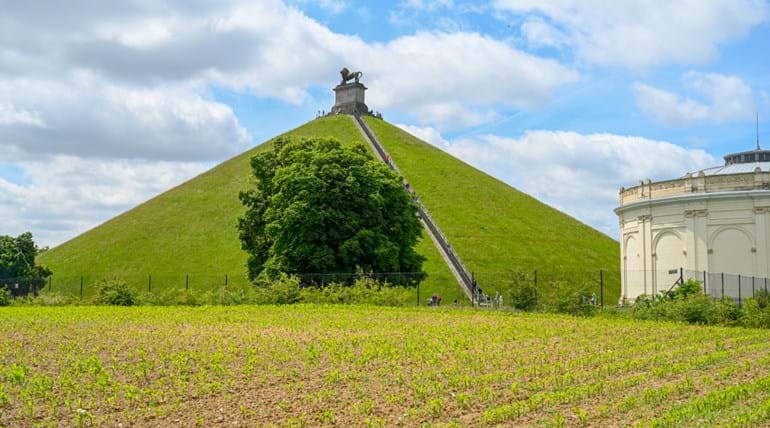 Lion’s Mound, the Waterloo memorial
Lion’s Mound, the Waterloo memorial
Of all Napoleon’s battles, it is the one at Waterloo in Belgium that he is perhaps most famous for. After escaping from Elba and returning to France in 1815, he seized power once again and met the British and Prussian forces commanded by the Duke of Wellington on June 18th near the village of Waterloo. Napoleon had won battles against the odds before, but this time his 72,000 men were defeated.
Today the battle site is marked by the monumental ‘Lion’s Mound’, which after climbing 226 steps affords the best view of what was once the battlefield. There is also a visitor centre with multi-media presentations and artefacts from the battle. Waterloo is just a 2 ½ hour drive from our Calais terminal (no tolls), so well worth the visit.
Book your epic Napoleon journey with LeShuttle
Napoleon called the Channel ‘a mere ditch’ that ‘will be crossed as soon as someone has the courage to attempt it’. He didn’t manage to get across himself, but he would surely have approved of the Channel Tunnel.
LeShuttle takes you from Folkestone to Calais in just 35 minutes, ready for you to start your campaign in Napoleon’s footsteps across France and beyond.